 W
WThe United States Mint has minted over 20 different kinds of coins, of many different sizes. Often, it is difficult for people to get a grasp of what much of the historical coinage looked like, at least in relation to modern circulating coins. This chart shows all of the coin types, and their sizes, grouped by coins of similar size and by general composition.
 W
WThe America the Beautiful silver bullion coins comprise a series of silver bullion coins with a face value of a quarter dollar. The coins contain five troy ounces of silver, making them the largest silver bullion coins ever issued by the United States Mint. The design of the coins duplicates exactly—though enlarged—each of the America the Beautiful quarters. They were issued from 2010 to 2021. The coins were available for sale during the year in which their corresponding circulating coin is issued. The coins are distributed by the United States Mint's network of authorized bullion dealers, and may be resold at the discretion of the Director of the National Park Service.
 W
WThe American Buffalo, also known as a gold buffalo, is a 24-karat bullion coin first offered for sale by the United States Mint on June 22, 2006, and available for shipment beginning on July 13. The coin follows the design of the Indian Head nickel and has gained its nickname from the American Bison on the reverse side of the design. This was the first time ever that the United States Government has minted pure (.9999) 24-karat gold coins for the public. The coin has a legal tender (face) value of US$50. Due to a combination of the coin's popularity and the tremendous increase in the price of gold since its creation the coin's value has increased considerably in a short time of just a few years. The initial 2006 U.S. Mint price of the proof coin was $800. In 2007 the Mint proof coin was $899.95, $1,410.00 in 2009, and $2,010.00 in 2011.
 W
WThe American Palladium Eagle is the official palladium bullion coin of the United States. Each coin has a face value of $25 and contains 99.95% fine palladium. It was authorized by the American Eagle Palladium Bullion Coin Act of 2010 which became Public Law 111-303 passed during the 111th United States Congress. The Palladium Eagle uses Adolph Weinman's obverse design on the Mercury dime, Liberty wearing a winged hat, while its reverse design is based on Weinman's 1907 American Institute of Architects (AIA) medal design.
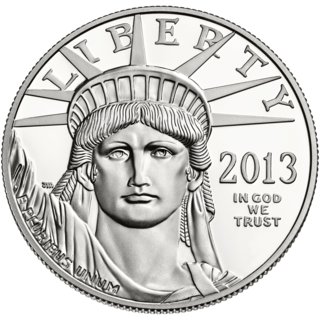 W
WThe American Platinum Eagle is the official platinum bullion coin of the United States. In 1995, Director of the United States Mint Philip N. Diehl, American Numismatic Association President David L. Ganz, and Platinum Guild International Executive Director Jacques Luben began the legislative process of creating the Platinum Eagle. After over two years of work, the 99.95% fine platinum coins were released by the United States Mint in 1⁄10, 1⁄4, 1⁄2 and 1 troy oz denominations. In late 2008, the fractional denominations were discontinued, leaving only the one ounce denomination. The Platinum Eagle is authorized by the United States Congress, and is backed by the United States Mint for weight, content, and purity.
 W
WThe Barber coinage consists of a dime, quarter, and half dollar designed by United States Bureau of the Mint Chief Engraver Charles E. Barber. They were minted between 1892 and 1916, though no half dollars were struck in the final year of the series.
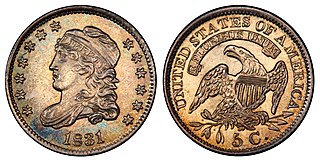 W
WThe Capped Bust coinage of the United States consisted of a half dime, dime, quarter and half dollar.
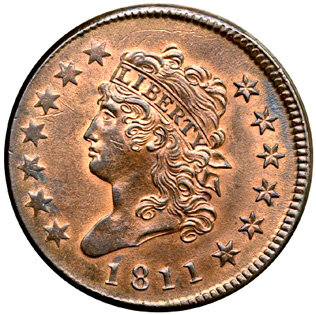 W
WThe Classic Head was a coin design issued by the United States Mint in the early 19th century. It was introduced for copper coinage in 1808 by engraver John Reich and later redesigned and improved by Chief Engraver William Kneass.
 W
WThe Coinage Act of 1965, Pub.L. 89–81, 79 Stat. 254, enacted July 23, 1965, eliminated silver from the circulating United States dime and quarter dollar coins. It also reduced the silver content of the half dollar from 90 percent to 40 percent; silver in the half dollar was subsequently eliminated by a 1970 law.
 W
WThe Coronet large cent was a type of large cent issued by the United States Mint at the Philadelphia Mint from 1816 until 1839.
 W
WA double eagle is a gold coin of the United States with a denomination of $20. The coins are made from a 90% gold and 10% copper alloy and have a total weight of 1.0750 troy ounces.
 W
W"Draped Bust" was the name given to a design of United States coins. It appeared on much of the regular-issue copper and silver United States coinage, 1796–1807. It was designed by engraver Robert Scot.
 W
WGoloid is an alloy of silver, gold and copper patented by Dr. William Wheeler Hubbell on May 22, 1877. The patent specifies 1 part gold, 24 parts silver, and 2.5 parts copper ; however, the patent also states that "The proportions may be slightly varied" and goes on to specify that the silver portion can range from 20 times to 30 times that of the gold, and the copper could range from one-eighth to one-twelfth of the total mixture. The patent specifies that the metals be separately melted, then mixed, along with "sulphate of sodium or sulphate of potassium" in the amount of one part sulfate to one thousand parts metal. The alloy, in varying proportions, was used by the United States Mint to strike pattern dollars, sometimes called "metric dollars" from 1878 to 1880. Patterns of the same design were struck in other metals, including aluminum, copper, normal coin silver, lead, and white metal.
 W
WA Guide Book of United States Coins , first compiled by R. S. Yeoman in 1946, is a price guide for coin collectors of coins of the United States dollar, commonly known as the Red Book.
 W
WThe Indian Head gold pieces or Pratt-Bigelow gold coins were two separate coin series, identical in design, struck by the United States Mint: a two-and-a-half-dollar piece, or quarter eagle, and a five-dollar coin, or half eagle. The quarter eagle was struck from 1908 to 1915 and from 1925–1929. The half eagle was struck from 1908 to 1916, and in 1929. The pieces remain the only US circulating coins with recessed designs. These coins were the last of their denominations to be struck for circulation, ending series that began in the 1790s.
 W
WThe Liberty Cap half cent was the first half cent coin produced by the United States Mint. It was issued from 1793 until 1797.
 W
WThe Nova Constellatio coins are the first coins struck under the authority of the United States of America. These pattern coins were struck in early 1783, and are known in three silver denominations, and one copper denomination (5-Units). All known examples bear the legend "NOVA CONSTELLATIO" with the exception of a unique silver 500-Unit piece.
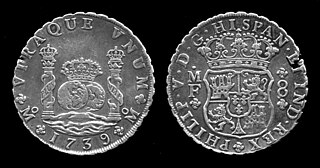 W
WThe numismatic history of the United States began with Colonial coins such as the pine tree shilling and paper money; most notably the foreign but widely accepted Spanish piece of eight, ultimately descended from the Joachimsthaler and the direct ancestor of the U.S. Dollar.
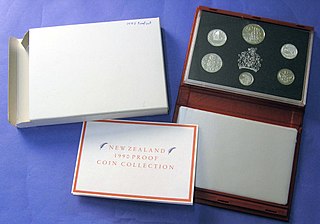 W
WProof coinage refers to special early samples of a coin issue, historically made for checking the dies and for archival purposes, but nowadays often struck in greater numbers specially for coin collectors (numismatists). Nearly all countries have issued proof coinage.
 W
WThe ring cent or holey cent was a one-cent pattern coin first struck in various compositions and designs between 1850 and 1851 as part of an experiment on producing a cent with a reduced weight and diameter, as the rising price of copper had caused cents to cost more than their face value to produce. Many varieties exist, with differing designs as well as differing compositions, including billon (standard), aluminum, copper, cupronickel, nickel silver, nickel, silver, and white metal.
 W
WThe Thomas Alva Edison silver dollar is a commemorative silver dollar issued by the United States Mint in 2004. It portrays American inventor Thomas Edison.
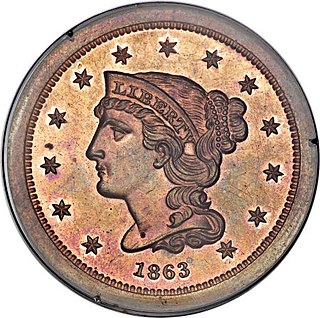 W
WThe three-cent bronze was a pattern coin struck in 1863 by George Eckfeldt. The coin shares its obverse design, thickness, and diameter with that of the Braided Hair large cent, but was made of bronze rather than pure copper. Weighing 140 grains, it weighted nearly three times that of the bronze Indian Head cent. About 50 to 60 examples are known.
 W
WThe copper-nickel three-cent piece, often called a three-cent nickel piece or three-cent nickel, was designed by US Mint Chief Engraver James B. Longacre and struck by the United States Bureau of the Mint from 1865 to 1889. It was initially popular, but its place in commerce was supplanted by the five-cent piece, or nickel.
 W
WThe United States three cent piece was a unit of currency equaling 3⁄100 of a United States dollar. The mint produced two different three-cent coins for circulation: the three-cent silver and the three-cent nickel. Additionally, a three-cent bronze coin was made as a pattern in 1863. During the period from 1865 to 1873, both coins were minted, albeit in very small quantities for the silver three-cent piece.
 W
WThe three-cent silver, also known as the three-cent piece in silver or trime, was struck by the Mint of the United States for circulation from 1851 to 1872, and as a proof coin in 1873. Designed by the Mint's chief engraver, James B. Longacre, it circulated well while other silver coinage was being hoarded and melted, but once that problem was addressed, became less used. It was abolished by Congress with the Coinage Act of 1873.
 W
WThe two-cent billon was a pattern US coin struck in 1836 and initially proposed as part of the Act of January 13, 1837. Versions exist with either a reeded edge and coin orientation or a plain edge and medal orientation; however, those with the former tend to be original strikes, whereas the latter are always proof restrikes.
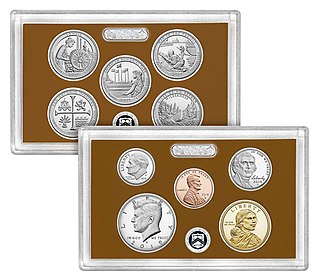 W
WThe United States Mint Proof Set, commonly known as the Proof Set in the United States, is a set of proof coins sold by the United States Mint. The proof set is popular with coin collectors as it is an affordable way to collect examples of United States coinage in proof condition.
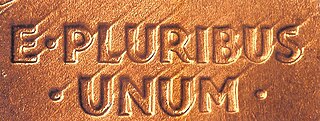 W
WThe wavy step or trails error is a die error that is found on some United States minted coins beginning in 1986. The anomaly occurs during the die making by the single-squeeze hubbing process.